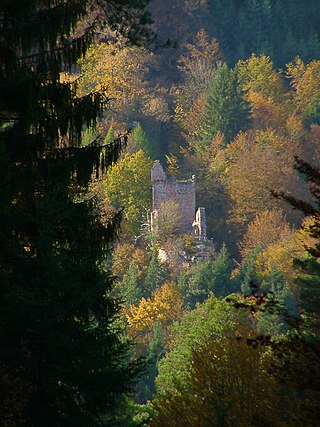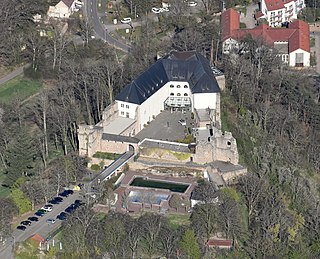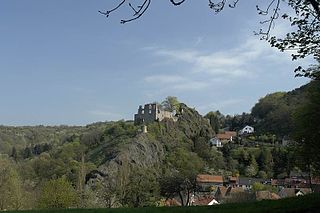
The House of Leiningen is the name of an old German noble family whose lands lay principally in Alsace, Lorraine, Saarland, Rhineland, and the Palatinate. Various branches of this family developed over the centuries and ruled counties with Imperial immediacy.

The Grafen von Falkenstein was a dynasty of German nobility descending from the Ministeriales of Bolanden, who held land and a castle at Falkenstein in the Palatinate region.

Battenberg Castle is a castle ruin near Battenberg in the county of Bad Dürkheim in the state of Rhineland-Palatinate, Germany.

Blumenstein Castle is a castle ruin in the Palatinate Forest in Rhineland-Palatinate, Germany. According to the State of Rhineland-Palatinate, Blumenstein castle was probably constructed in the first half of the 13th century as part of a line of defensive castles along the Alsatian border.

The Hardenburg on the eastern edge of the Palatinate Forest near the Rhineland-Palatinate town of Bad Dürkheim is even as a ruin one of the mightiest castles of Palatinate. It was the residence of the Counts of Leiningen, who in 1725 moved to Schloss Dürkheim.

Spangenberg Castle is the partially rebuilt ruin of a rock castle in the German state of Rhineland-Palatinate. It lies in the Palatine Forest above the Elmstein valley near the village of Erfenstein, but is actually on the forest estates belong to the town of Neustadt an der Weinstraße, or more precisely, the village of Lachen-Speyerdorf. Together with the neighbouring castle of Erfenstein, it is linked to the legend of the Leather Bridge.

Frankenstein Castle is a medieval fortification on a spur above the village of Frankenstein, Rhineland-Palatinate in the Palatinate Forest in Germany. Its name derives from the local House of Frankenstein.

The Frankenweide is a hill region in the German state of Rhineland-Palatinate. It forms the central part of the Palatine Forest in the Palatinate region.

Gräfenstein Castle is a ruined rock castle about 2 kilometres (1.2 mi) east of the village of Merzalben in the German state of Rhineland-Palatinate. It is in the county of Südwestpfalz within the Palatine Forest and is often called Merzalber Schloss. It is built on a rock plateau 12 metres (39 ft) high at an elevation of 447 metres (1,467 ft) above sea level.

Grafendahn Castle lies in the southern Palatine Forest, the German part of the Wasgau region, just under 1 kilometre east of the small town of Dahn in the state of Rhineland-Palatinate.

Erfenstein Castle is a medieval spur castle in the German state of Rhineland-Palatinate. It lies within the Palatine Forest above the Elmstein Valley at 265 m above sea level (NN) in the vicinity of the hamlet of Erfenstein in the municipality of Esthal. Together with nearby Spangenberg Castle, it is linked to the legend of the Leather Bridge.

The ruins of Breitenstein Castle stand on a crag, 220 metres (720 ft) high, on the northern side of the Speyerbach valley in the Palatine Forest in Germany. The castles is 4 kilometres (2.5 mi) east of the village of Elmstein in the county of Bad Dürkheim in the state of Rhineland-Palatinate.

Altleiningen is a castle in the Palatinate Forest in Germany. It lies in the parish of Altleiningen in the county of Bad Dürkheim in the German state of Rhineland-Palatinate.

Guttenberg Castle is a ruined rock castle near the French border in the German part of the Wasgau, which in turn is part of the Palatine Forest in the state of Rhineland-Palatinate.

Hohenecken Castle is the ruin of a spur castle from the Hohenstaufen era on the Schlossberg hill above the Kaiserslautern ward of Hohenecken in Rhineland-Palatinate, Germany. It is located at an elevation of 363 m above sea level (NN).

Falkenstein Castle is a ruined hill castle dating to the Middle Ages. It is situated above the eponymous village of Falkenstein on the Donnersberg, the highest point in the Palatinate region, which rises within the German state of Rhineland-Palatinate.

Old Wolfstein Castle, is a ruined hillside castle on the eastern slopes of the Königsberg at the narrowest point in the Lauter valley near Wolfstein in the county of Kusel in the German state of Rhineland-Palatinate.

Hohenfels Castle is a ruined hill castle at a height of 545 m above sea level (NHN), in the Beutelfels Nature Reserve north of the village of Imsbach in the county of Donnersbergkreis in the German state of Rhineland-Palatinate. The castle may be reached via a steep footpath from the visitor mine of Weiße Grube in the valley of Langental. The path passes the "Iron Man" monument.

New Bolanden Castle is a ruined spur castle and, today, a cultural monument. It stands at a height of 260 m on the 276-metre-high Schlossberg hill immediately east of the village of Bolanden in the county of Donnersbergkreis in the German state of Rhineland-Palatinate.

Reipoltskirchen Castle is a water castle in the parish of Reipoltskirchen in the county of Kusel in the German state of Rhineland-Palatinate. It is one of the best preserved water castles in the Palatinate region.























